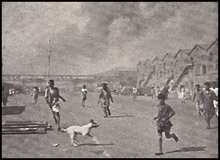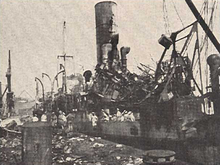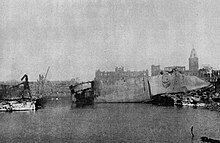
Liberty ships were a class of cargo ship built in the United States during World War II under the Emergency Shipbuilding Program. Although British in concept, the design was adopted by the United States for its simple, low-cost construction. Mass-produced on an unprecedented scale, the Liberty ship came to symbolize U.S. wartime industrial output.

The 1947 Texas City disaster was an industrial accident that occurred on April 16, 1947, in the port of Texas City, Texas, United States, located in Galveston Bay. It was the deadliest industrial accident in U.S. history and one of history's largest non-nuclear explosions.
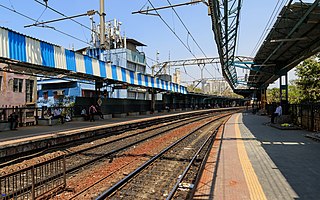
Cotton Green is a suburb of Mumbai, and a noted residential and commercial area east of Parel, in central Mumbai, 8 km north of Colaba. It is also the name of a railway station on the Mumbai suburban railway, which lies along the Harbour line, which is a part of the Central Railway.

The history of Mumbai can be traced back to 600 BC, with evidence of the first known settlement of the Harrappan civilization discovered in the region.
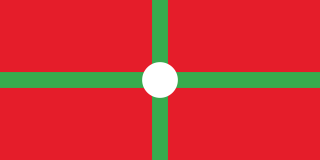
Ellerman Lines was a UK cargo and passenger shipping company that operated from the late nineteenth century and into the twentieth century. It was founded in the late 19th century, and continued to expand by acquiring smaller shipping lines until it became one of the largest shipping firms in the World. Setbacks occurred through heavy losses to its merchant fleet in the First and Second World Wars but were overcome in each case.
There have been many extremely large explosions, accidental and intentional, caused by modern high explosives, boiling liquid expanding vapour explosions (BLEVEs), older explosives such as gunpowder, volatile petroleum-based fuels such as gasoline, and other chemical reactions. This list contains the largest known examples, sorted by date. An unambiguous ranking in order of severity is not possible; a 1994 study by historian Jay White of 130 large explosions suggested that they need to be ranked by an overall effect of power, quantity, radius, loss of life and property destruction, but concluded that such rankings are difficult to assess.
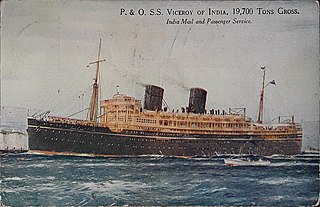
RMS Viceroy of India was an ocean liner of the Peninsular and Oriental Steam Navigation Company (P&O). She was a British Royal Mail Ship on the Tilbury–Bombay route and was named after the Viceroy of India. In World War II, she was converted to and used as a troopship. She was sunk in the Mediterranean in November 1942 by German submarine U-407.

SS City of Johannesburg was a British cargo steamship that was sunk in 1942. She was built by Barclay, Curle & Co, of Whiteinch, Glasgow in 1920, for Hall Lines of Liverpool, a subsidiary of Ellerman Lines, being launched as SS Melford Hall. She was renamed SS City of Johannesburg in 1926.
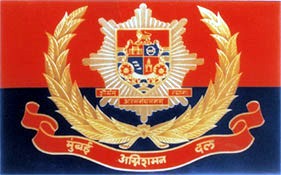
The Mumbai Fire Brigade is the fire brigade serving the city of Mumbai, India. It is responsible for the provision of fire protection as well as responding to building collapses, drownings, gas leakage, oil spillage, road and rail accidents, bird and animal rescues, fallen trees and taking appropriate action during natural disasters.
SS Fort La Montee was a North Sands-class cargo ship, built during the Second World War and seeing use as an ammunition transport for the Allies in the Mediterranean Theatre.
Indigenous tribals have inhabited Mumbai (Bombay) since the Stone Age. The Kolis and Aagri were the earliest known settlers of the islands. Between the 2nd century BCE and 10th century CE, the islands came under the control of successive indigenous dynasties: the Satavahanas, Abhiras, Vakatakas, Kalachuris, Konkan Mauryas, Chalukyas, Rashtrakutas, Silharas & Chollas.
The history of Mumbai during the 21st century covers the Indian city of Mumbai in the 21st century.

SSMont-Blanc was a cargo steamship that was built in Middlesbrough, England in 1899 for a French shipping company. On Thursday morning, December 6, 1917, she entered Halifax Harbour in Nova Scotia, Canada laden with a full cargo of highly volatile explosives. As she made her way through the Narrows towards Bedford Basin, she was involved in a collision with Imo, a Norwegian ship. A fire aboard the ship ignited her cargo of wet and dry 2,300 tons of picric acid, 500 tons of TNT, and 10 tons of guncotton. The resultant Halifax Explosion killed approximately 2,000 people and injured about 9,000.
HMIS El Hind (F120) was a merchant ship that was requisitioned by the Royal Indian Navy (RIN) in 1943. She was commissioned, and served as a Landing Ship, Infantry (Large) during World War II. She was destroyed in a fire in 1944.

The Fort ships were a class of 198 cargo ships built in Canada during World War II for use by the United Kingdom. They all had names prefixed with "Fort" when built. The ships were in service between 1942 and 1985, with two still listed on shipping registers until 1992. A total of 53 were lost during the war due to accidents or enemy action. One of these, Fort Stikine, was destroyed in 1944 by the detonation of 1,400 tons of explosive on board her. This event, known as the Bombay Explosion, killed over 800 people and sank thirteen ships. Fort ships were ships transferred to the British Government and the Park ships were those employed by the Canadian Government, both had the similar design.

Fort Stikine was a British Fort ship which was built in Canada in 1942. Owned by the American War Shipping Administration, she was leased under charter to the Ministry of War Transport under the Lend-Lease scheme and operated under the management of the Port Line. Fort Stikine only had a short career, and was destroyed in an explosion at Bombay, India, in April 1944 that caused the loss of a further thirteen ships.

The SS Canada Victory was one of 531 Victory ships built during World War II under the Emergency Shipbuilding program. She was launched by the Oregon Shipbuilding Corporation on January 12, 1944, and was completed on February 28, 1944. The ship’s United States Maritime Commission designation was VC2-S-AP3, hull number 93 (1009). The Maritime Commission turned her over to a civilian contractor, the Alaska SS Company, for operation.

SS Logan Victory was a cargo Victory ship built for World War II under the Emergency Shipbuilding program. The Logan Victory was launched January 16, 1945, by Permanente Metals Corporation, Richmond, California and completed on February 6, 1945. She was operated by the American-Hawaiian Steamship Company under the United States Maritime Commission.
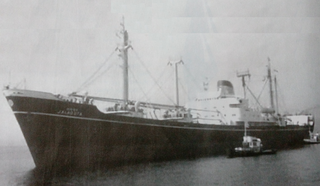
SS Jalabala was the cargo steamship owned by Scindia Steam Navigation Company Ltd., the British Indian shipping company, which was completed in 1927. She was torpedoed and sunk in the Laccadive Sea west of Cape Comorin by the German submarine U-532 with the loss of five of her 77 crew members on 11 October 1943 during World War II.


